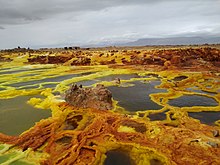Tourism in Ethiopia
The tourism in Ethiopia benefited from the fact that the country is one of the oldest civilizations in the world and the past dynasties of the Aksumite Empire and the empire of Abyssinia have left numerous buildings. In addition, due to its altitude, climatic conditions and the resulting development of flora and fauna , Ethiopia has a special natural world to offer on the African continent , the use of which would only make sense in the sense of ecotourism .
Tourism accounts for 5.5% of the total gross domestic product within the Ethiopian economy and has increased by 2% compared to the previous year. The government shows its commitment and willingness to develop the tourism industry through a number of initiatives. Tourism is a capable component of strategy work to reduce poverty in Ethiopia and stimulate economic development.
Ethiopia as a travel destination
Tourist destinations in Ethiopia include Ethiopia's collection of national parks (especially the Simien National Park ) and numerous historical sites (especially those in Aksum and Lalibela ).
Booming in the 1960s, the importance of tourism to the Ethiopian economy fell sharply under the Derg regime in the late 1970s and 1980s. A small recovery began in the 1990s, but growth is hampered by periods of drought, political instability and the lack of effective hotels and other infrastructure - despite the boom in the construction of small and medium-sized restaurants and hotels. The political events surrounding the elections in May 2005 and the country's structural weakness are a problem, especially for the tourism sector. This was partly due to the international attention gained through the return of the Aksum obelisk from Rome and a major concert on Bob Marley's 60th birthday in change nothing in the same year.
Tourist infrastructure
Overnight stays
Travel has a long tradition in Ethiopia, so there are so-called hotels everywhere in the country, no matter how small the place is. Their standard takes getting used to, especially in remote areas. Due to the conferences of the Addis Ababa-based organizations of the African Union and the United Nations Commission for Africa , the capital's large hotels are regularly booked out. That is why the decision was made in January 2005 to have two new hotels built for a total of 17 million US dollars by a Kuwaiti-French consortium. In Northern Ethiopia there is the Historical Route. In every city there is a hotel belonging to the state hotel chain that meets “western” standards.
mobility
All cities are served by Ethiopian Airlines .
Tour operator on site
The largest local tour operator is the Ethiopian Ministry of Culture and Tourism , which had to present a large-scale organization for an event on the occasion of the Ethiopian Millennium in 2007.
A positive aspect is that the popularity of ecotourism is increasing, which also has significant potential for growth in Ethiopia. High growth is expected in the tourism industry, as it grew by 7% in 2006 and 5% in 2007. Sales are driven primarily by the growing interest in eco-tourism package deals - including adventure travel , trekking and walking safaris - which make up a large portion of tour operators' revenues.
Attractions
Sights include Bahir Dar on Lake Tana , (Blue) Nile Falls, Gondar / Gonder (baroque palace complex), Simien National Park , Axum (cathedral, stele fields), Lalibela (rock - hewn churches), Awash National Park (with Awash waterfall), Langano Lake, Dire Dawa (French flair).
Culture
- Churches in Lalibela
- Palace in Gonder
- Harar is also worth seeing and experiencing (90 mosques, Rimbaud house, world cultural heritage).
- Monasteries on Lake Tana
nature
- the Danakil desert ( crossed on foot by Rüdiger Nehberg in the 1970s)
literature
- German-Ethiopian Association: Information sheets. Art and tourism , Dreisteinfurt 2005.
- German-Ethiopian Association: Information sheets. Tourism in Ethiopia , Dreisteinfurt 1997.
Web links
- Ethiopian Ministry of Culture and Tourism (English, Amharic, Oromo, Tigrinya).
Individual evidence
- ↑ a b Travel and Tourism in Ethiopia . In: Euromonitor . (English)
- ↑ Ethiopia's country profile (PDF; 161 kB). Library of Congress Federal Research Division (April 2005).
- ↑ Open Letter to PM Meles Zenawi of Ethiopia - MILLENNIUM pageant. In: nazret.com. March 3, 2009, archived from the original on March 14, 2009 ; accessed on September 11, 2017 (English).
- ↑ Patricia Erfurt-Cooper, Malcolm Cooper: Volcano and Geothermal Tourism. Sustainable Geo-Resources for Leisure and Recreation Earthscan / James & James, 2010, ISBN 9781844078707 .

